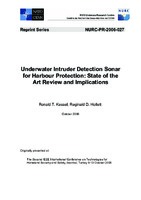| dc.contributor.author | Kessel, Ronald T. | |
| dc.contributor.author | Hollett, Reginald D. | |
| dc.date.accessioned | 2018-10-11T14:09:28Z | |
| dc.date.available | 2018-10-11T14:09:28Z | |
| dc.date.issued | 2006/08 | |
| dc.identifier | 25007 | |
| dc.identifier.govdoc | NURC-PR-2006-027 | |
| dc.identifier.uri | http://hdl.handle.net/20.500.12489/609 | |
| dc.description.abstract | Sonar is the sensor of choice for wide-area underwater surveillance because sonar (based on sound waves) typically provides a much larger area of coverage than radar (electromagnetic waves) or video (visible light) can provide under water. Of particular interest of late is sonar for detecting and tracking underwater intruders in harbours, to provide an element of protection for ships, harbour infrastructure, nuclear power plants, and so forth, against terrorist attacks carried out from underwater. Sonar has long been used for detection and tracking by the military, but the application against intruders is relatively new as the mandate of civilian security agencies and the military expands now to include protection against terrorist attacks and counter terrorism. This paper reports | |
| dc.description.abstract | the general results of a survey of commercial sonar systems (not including system-bysystem | |
| dc.description.abstract | rankings or detailed matters of procurement), as well their validation in part through sea trials and modeling, and on factors relevant to their use as a component in harbour protection. | |
| dc.format | 12 p. : ill. : digital, PDF file | |
| dc.language | English | |
| dc.publisher | NURC | |
| dc.source | In: The Second IEEE International Conference on Technologies for Homeland Security and Safety, Istanbul, Turkey 9-13 October 2006. | |
| dc.subject | Port and harbour protection | |
| dc.subject | Divers, protection from | |
| dc.title | Underwater intruder detection sonar for harbour protection: state of the art review and implications | |
| dc.type | Reprint (PR) | |
| dc.type | Papers and Articles | |
